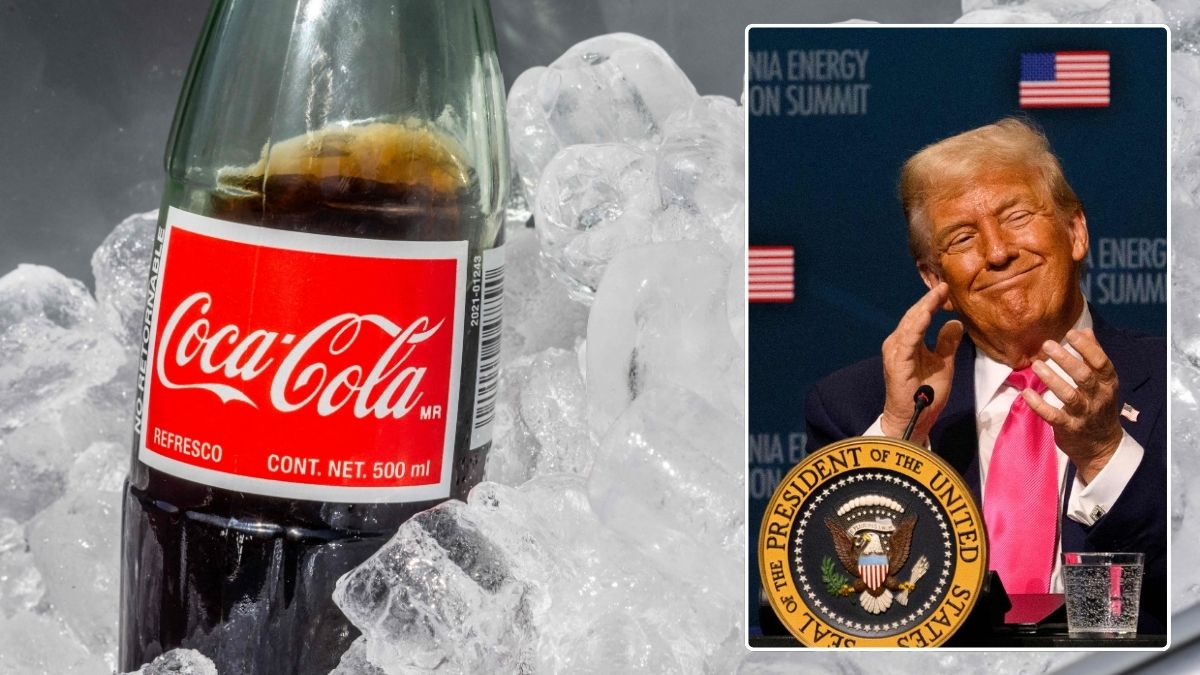Will ‘Mexican Coke’ become the new standard? Trump calls for Coca-Cola to replace corn syrup with cane sugar
 Coca-Cola from Mexico; US President Donald Trump (inset) | AFP
Coca-Cola from Mexico; US President Donald Trump (inset) | AFP
US President Donald Trump is now aiming policy changes at the consumer market, specifically at soft drink giant Coca‑Cola. In a post on his social media platform Truth Social, Trump claims he has urged Coca‑Cola to replace high-fructose corn syrup (HFCS) in its American products with cane sugar, similar to what is used in the Mexican variant of the drink.
“I have been speaking to Coca-Cola about using REAL Cane Sugar in Coke in the United States, and they have agreed to do so,” Trump stated. He added, “I’d like to thank all of those in authority at Coca-Cola. This will be a very good move by them—You’ll see. It’s just better!”
Cane sugar, also known as sucrose, is a naturally occurring sweetener derived from sugarcane or sugar beets, consisting of equal parts glucose and fructose chemically bonded together. On the other hand, high-fructose corn syrup (HFCS) is a processed sweetener made from cornstarch.
Soft drink companies, including Coca-Cola, most commonly use HFCS-55, which consists of around 55 per cent fructose and 42 per cent glucose, with the sugars unbonded.
Although both are structurally similar and yield nearly identical caloric content (around 4 calories per gram), some consumers note a difference in taste. Cane sugar is often described as cleaner or more balanced in sweetness, while HFCS is said to have a slightly heavier or syrupier profile. However, studies involving blind taste tests have produced mixed results. Many participants struggle to differentiate between the two, while preferences for Mexican Coke mostly came from its heavier and more premium packaging.
The move to HFCS was mainly driven by economic and regulatory factors. The 1970s and 1980s saw a significant rise in sugar prices across the globe, and US agricultural policy created strong incentives and subsidies for corn production. In those circumstances, HFCS emerged as a cost-effective, domestically sourced alternative to cane sugar, becoming the standard sweetener in most American soft drinks by the mid-80s. Additionally, HFCS offers a longer shelf life and consistent supply, checking the box for manufacturers like Coca‑Cola and many others. The shift was a practical decision rather than a response to consumer preference.
A healthier option?
Now the question arises: Is cane sugar actually a healthier alternative to HFCS? From a nutritional and metabolic standpoint, the differences between the two sweeteners are negligible. Both are forms of added sugar composed of glucose and fructose and are also metabolised in similar ways, with HFCS holding an insignificantly higher level of fructose content (55 per cent in HFCS versus 50 per cent in cane sugar).
Health authorities consider both sweeteners to be contributors to excessive sugar consumption and its associated risks, including obesity, type 2 diabetes, and cardiovascular disease. Experts broadly agree that the primary concern is the quantity of sugar consumed, not the source.
So what drives consumers towards “Mexican Coke”? Unlike the American recipe, Mexican Coke is made with cane sugar in place of HFCS. Many claim it tastes better and is more natural, while others are drawn to the vintage glass packaging. This variant also does not have the heavy, syrupy aftertaste one experiences in the regular Coke. Although differences in flavour can be subjective, the product has developed a devoted following in the US, especially among those seeking alternatives to corn-based sweeteners and minimally processed ingredients.
Practically speaking, replacing HFCS with cane sugar in the soft drink’s product line would be highly complex and costly. Industry estimates suggest such a shift could increase manufacturing expenses by a significant margin, owing to the higher cost of cane sugar and the need for extensive supply chain adjustments. There would also be significant agricultural and political implications.
The Corn Refiners Association, which represents a major segment of US corn growers, has voiced opposition to this change. Its CEO, John Bode, has warned of impacts on employment, rural economies, and corn prices.
Given that corn is one of the United States’ most heavily subsidised crops, any large-scale move away from HFCS would likely provoke political resistance, especially from the Midwest. However, it would greatly benefit Trump’s home state of Florida, which is the country’s largest producer of sugarcane.
Additionally, US sugar imports are regulated through quota systems that limit how much cane sugar can be brought into the country. It will be difficult and costly to source enough cane sugar to replace HFCS at scale, unless there is a change in trade policy.
Rather than overhaul its entire sweetener strategy, Coca‑Cola might be more likely to offer expanded options, including an increased presence of cane sugar–sweetened sodas, such as those modelled after Mexican Coke, or new “heritage” or “original recipe” product lines.
This would allow Coca‑Cola to cater to evolving consumer preferences without disrupting its core operations or alienating the cost-conscious majority. A dual strategy like this could address both commercial and political pressures. Market reactions also suggest measured optimism.
Coca‑Cola’s stock experienced a slight increase following Trump’s statement, while shares in corn syrup suppliers have seemingly tanked. This reflects investor uncertainty over potential changes in the company’s procurement strategy.
While the President’s public advocacy for cane sugar Coke may strike some as unconventional, it taps into a broader interest in authenticity, nostalgia, and health consciousness. Whether or not Coca‑Cola enacts any substantial reformulation is yet to be seen, although consumer reactions reflect a growing desire for transparency and choice.
Business